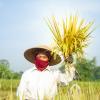Two new studies produced by an international team, including a scientist working in partnership with IIASA, demonstrate that the impact of the global rubber trade on forests and biodiversity has been substantially underestimated and new sustainable solutions are urgently needed to address this problem.
Natural rubber is a key material used to produce a wide variety of goods, which play an important role in our daily lives — from medical devices to clothes and cutlery. With 70% of the world’s natural rubber used just for tire manufacturing, the demand for this raw material is not likely to decline anytime soon. Natural rubber is often considered to be a renewable resource, as it is mostly produced from the latex of the so-called “rubber tree” (Hevea brasiliensis), which grows in tropical regions. However, its planting practices often involve clearing natural forests, resulting in serious biodiversity loss and net carbon emissions.
The findings of two new studies highlight that the impact of the global rubber trade on forests is significantly larger than previously reported estimates, which have been used to inform political decision-making at the global and national levels so far. This conclusion is based on the latest satellite technology and cloud computing, as well as a review of more than 100 case studies.
The first study, titled “Rubber's inclusion in zero-deforestation legislation is necessary but not sufficient to reduce impacts on biodiversity”, conducts a systematic literature review concerning transitions to and from rubber, revealing substantial rubber plantation area expansion since 2010 at the expense of natural forests. It also focuses on future trends and the relations between rubber production and EU deforestation regulations. The second study, titled “High-resolution maps show that rubber causes substantial deforestation”, is focused primarily on conducting mapping of deforestation areas for rubber production across Southeast Asia.
“Our analysis shows that substantial expansion of rubber plantations has occurred in many producer countries since 2010, with particularly rapid increases in new locations such as Cote d’Ivoire. Some 2.7 million to 5.3 million hectares of additional harvested area could be needed to meet industry estimates of demand by 2030,” highlights Eleanor Warren-Thomas, a lead author and co-author of the two studies, respectively, IIASA-NERC Collaborative Research Fellow and Lecturer at Bangor University. “It is critical that existing rubber producers are supported to improve their yields and maintain production to avoid ongoing expansion of plantation area.”
Both studies conclude that rubber deserves more attention in domestic policy, within trade agreements, and in incoming due-diligence legislation. Other key takeaways include the necessity of further enhancing the evidence base available to inform policy decisions and to aid their implementation, such as the inclusion of rubber in the EU Deforestation Law, as well as ensuring that smallholders, who account for 85% of natural rubber production, are not marginalized by the new regulations.
The papers were recently published in the journals Conservation Letters and Nature as a result of joint efforts of scholars at Bangor University/IIASA, Royal Botanic Garden Edinburgh and other partnered institutions, including: the Kunming Institute of Botany, China; Xishuangbanna Tropical Botanical Garden, China; Stockholm Environment Institute, University of York; University of Bern, Switzerland; Yunnan Academy of Social Sciences, China; and the University of Sheffield, UK.
Primary funders of the research were the UK Research and Innovation’s Trade, Development and Environment Hub to the UN Environment World Conservation Monitoring Centre and UK Research and Innovation NERC-IIASA Collaborative Research Fellowship.
References
Warren-Thomas, E., Ahrends, A., Wang, Y., Wang, M., Jones, J. (2023) Rubber's inclusion in zero-deforestation legislation is necessary but not sufficient to reduce impacts on biodiversity Conservation Letters DOI: 10.1111/conl.12967
Wang, Y., Hollingsworth, P., Zhai, D., West, C., Green, J., Chen, H., Hurni, K., Su, Y., Warren-Thomas, E., Xu, J., Ahrends, A. (2023) High-resolution maps show that rubber causes substantial deforestation Nature DOI: 10.1038/s41586-O23-O6642-z
News

23 July 2024
Fostering transformation of agrifood systems in Indonesia

22 July 2024
Are sustainable aviation fuels truly sustainable?

17 July 2024

